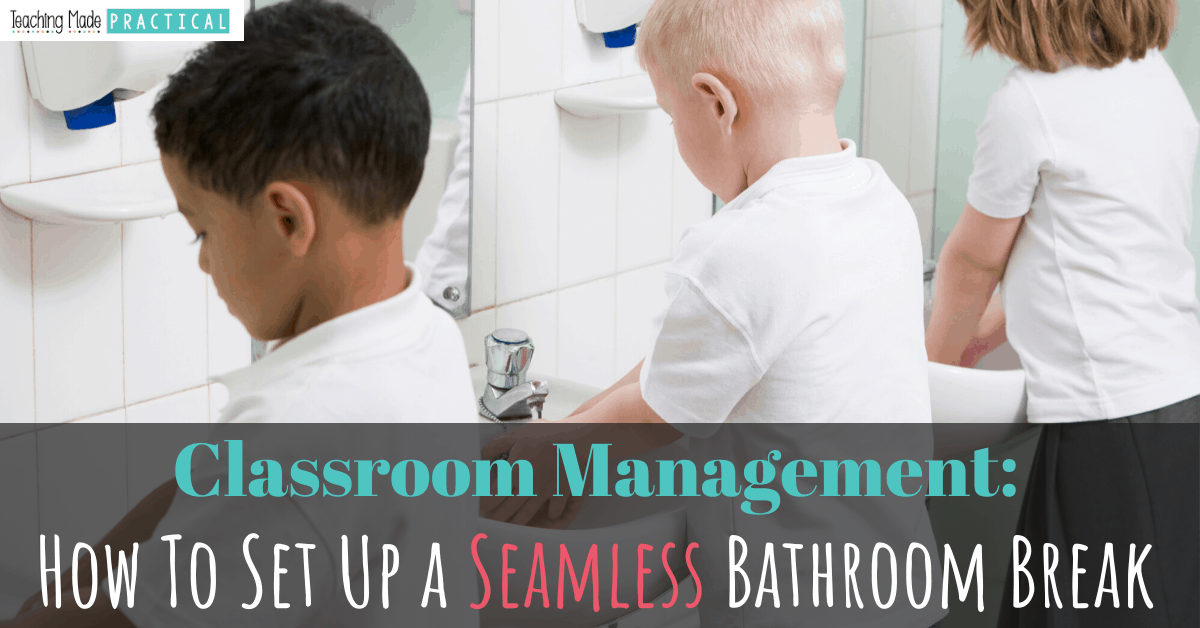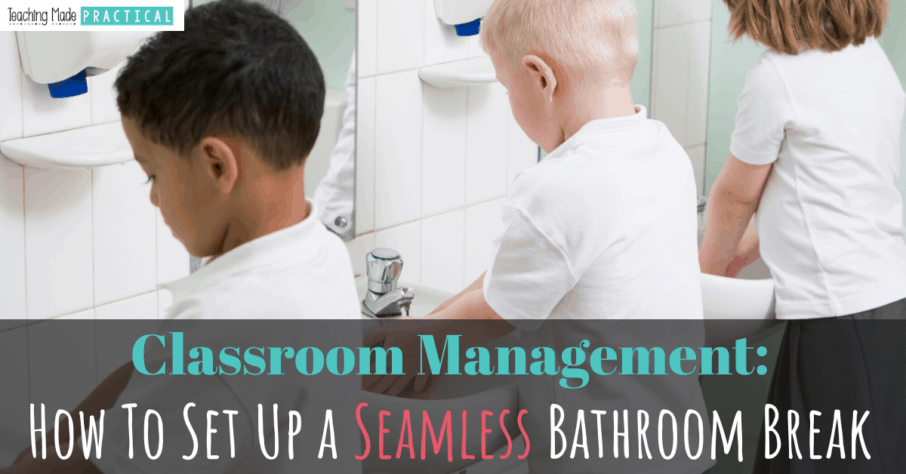
I'm convinced that more people would appreciate the worth of teachers if they were required to get 25+ students to use the bathroom quickly, quietly, and without making a mess. Creating good bathroom break procedures is a skill that elementary teachers have to finely tune if they want their year to run smoothly.
Throughout my years teaching, I experimented with what seemed like thousands of different bathroom procedure ideas. Some years, my classes would need minimal guidance - all I needed to do was show them where to wait their turn.
Other years, my students needed EXTREMELY specific procedures in place in order to be successful. It always worked best when I provided very specific, well thought-out procedures on the first day of school and became more lenient as my students proved themselves.
Below, find tips to consider regarding bathroom breaks - one of the more important procedures to figure out on this classroom procedures checklist.
Things to Consider Before Planning Your Bathroom Procedures
Before planning out your bathroom break procedures, it might be helpful to know if your school has any school-wide expectations regarding bathroom breaks. (Asking about bathroom procedures should be one of the questions you ask when you are starting at a new school.)
Many schools give teachers full control over how they will handle bathroom breaks, but some schools might expect you to do things a certain way. For example, one of the schools I taught at didn't allow any more than 4 students in the bathroom at any given time.
Your school might also have expectations about HOW students will take a bathroom break - individually or as a whole class. However, I've found that the majority of teachers usually do a mix of the two - taking students on whole class bathroom breaks several times a day, but also allowing students to go individually in case of an emergency.
If you're unsure of your school's policies, be prepared to adjust your procedures as needed.
It's helpful to have procedures for both so students know exactly what to do in both situations.
Your procedures can change each year depending on your students. Some years your students might be more responsible and are able to handle a lot more freedom. In general, I like to give students however much freedom they can handle without it becoming disruptive or problematic.
Fun, No Prep Halloween ELA Activities! Includes:
- Halloween Fun Packet
- History of Halloween Reading Passage
- Monster Descriptive Writing Activity
- Spooky Figurative Language
- Bats Reading Comprehension and Snowball Fight
Classroom Procedures for Whole Class Bathroom Breaks
Because the bathroom and hallway set up is different for every school, every classroom's bathroom break procedures are going to be a little different. However, there are some questions that EVERY upper elementary teacher should consider before creating their bathroom break procedures.
- Where will your students stand while waiting to use the bathroom?
- What will students do while they are waiting? Will they be allowed to talk?
- What will the students who do not need to use that bathroom do?
- How will students know that it is their turn to use the bathroom?
- How will you monitor student behavior while in the bathroom?
- How will you make sure students don't waste time while in the bathroom?
- How much soap and how many paper towels will students use to wash and dry their hands?
- Where will students throw away their trash?
- How will students get a drink of water?
- Where will students stand when they are finished?
- How will students get help if they need it - in case of an emergency or other questions they might have for you?
Having procedures in place for ALL of the questions above might seem like overkill (and it might be overkill, depending on your students), but I have found it is much easier to have very clear expectations upfront to prevent problems later on down the road.
I resisted the idea of having bathroom monitors for a long time, wanting to monitor everything myself. Eventually, however, I found that having a reliable set of bathroom monitors can really help prevent problems in the bathroom. See how I chose bathroom monitors (and other classroom jobs) here.
Classroom Procedures for Individual Bathroom Breaks
There are many different ways to handle how your students take individual bathroom breaks.
Some teachers allow students to go as needed, while other teachers have expectations in place about when individual bathroom breaks are allowed. (For example, some teachers don't allow students to go during whole class instruction.)
Some teachers have students use a sign-out sheet. Some teachers give their students a limited number of bathroom passes to use at their discretion. Some teachers simply have their students ask permission before going. Peppy Zesty Teacherista has digital bathroom passes to help document how often students were going to the bathroom.
I had students use hand signals to let me know that needed a bathroom or water break so that instruction wasn't constantly being interrupted.
However you decide to handle individual bathroom breaks in your classroom, there are several questions to consider as you think about procedures to set in place.
- How will students ask permission to use the bathroom so that it doesn't interrupt class time?
- How will you decide whether or not to give the student permission to go to the bathroom or not?
- Will students use bathroom passes?
- What will students do in case of an emergency - and how do you define emergency?
- How will you handle students that "need" to use the bathroom constantly?
- How (or will) you document how often students are using the bathroom?
Other Things to Consider when Planning Your Bathroom Break Procedures
1. The time students spend standing in line waiting for their class to use the bathroom can seem like wasted time. Many teachers have found ways to utilize the time that students spent waiting in line for the bathroom breaks. See how I utilized the time kids spent in line in the morning, as well as during bathroom breaks.
2. Put some thought into how many whole class bathroom breaks your class will take, and what time of day you will take those breaks. I've found that taking a morning bathroom break and an afternoon bathroom break is enough for most upper elementary students if you allow them to go individually as needed.
However, it was important to me that students got a chance to take a third bathroom break before lunch/recess (my students only had 20 minutes to get through the lunch line and eat) because I didn't want my students having to waste their limited lunch and recess time using the bathroom.
3. It can also be helpful to talk with other teachers to see what times they plan on taking bathroom breaks so that you can avoid those times and minimize the amount of class time wasted on bathroom breaks.
Whatever ideas you use to set up your bathroom break procedures, having a very specific plan in place can only help the rest of your year run more smoothly!
You might also be interested in some of my other classroom management tips for upper elementary:
32 Classroom Job Ideas
Overcoming the Pencil Problem
Morning Work Made Easy - and Free
Never Stress Over Sub Plans Again!

Make copies, find a fiction book, and you'll be ready for any emergency that comes your way!


